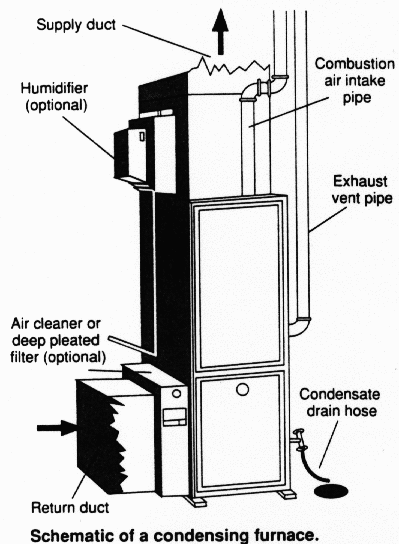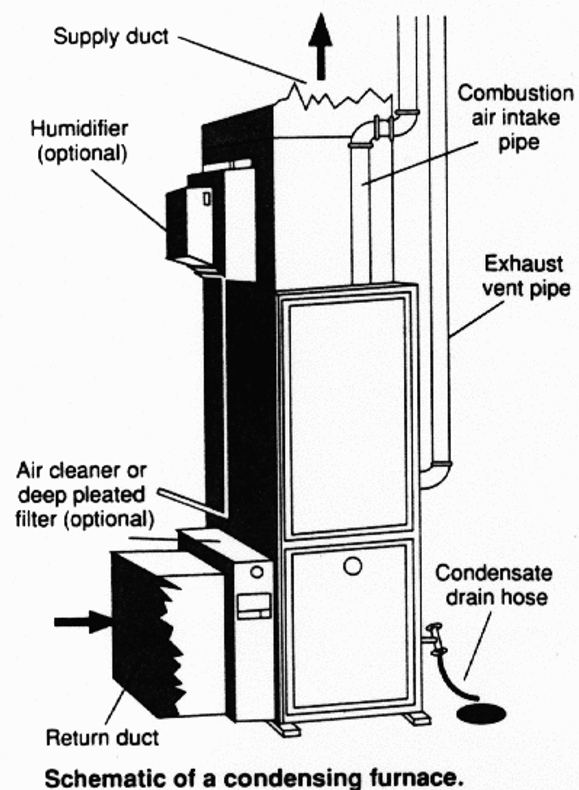
In order to explain the purpose of a condensate drain and a condensate trap for high-efficiency condensing gas furnaces and air-conditioner evaporator coils, let’s first begin by explaining the basics of condensing furnaces and air-conditioner evaporator coils.
Gas furnaces have been around for many years. Thousands of installed residential and commercial buildings utilize gas furnaces to provide heat during cold weather. There are many manufacturers of gas furnaces, but they all utilize the same basic components. In general, a furnace consists of a house air blower, gas valve, heat exchanger, and flue gas vent pipe. High-efficient gas furnaces also contain a condensate drain, trap, secondary heat exchanger, and draft fan. The purpose of the house air blower is to circulate air through the furnace and deliver warm air to the space. A heat exchanger transfers heat from the combustion gasses to the house air to warm it. Conversely, combustion gasses are cooled by the heat exchanger and are vented outside through the vent pipe.
What is a condensing furnace?
In an effort to improve efficiency and reduce energy consumption, the U.S. Department of Energy (DOE) has instituted minimum efficiency standards for residential gas furnace efficiency. In order for a furnace to qualify for the ENERGY STAR label, it must achieve an annual fuel utilization efficiency (AFUE) rating of 95% or greater.
Why does a condensing furnace produce condensate?
According to the DOE, all furnaces that meet the ENERGY STAR product specifications are condensing furnaces. In contrast to less efficient furnace, the high-efficient condensing furnaces reduce the heat normally exhausted in the flue gas and utilize this heat to improve the overall efficiency of the furnaces. The high-efficient gas furnaces reduce the exhaust gas temperature and extract more heat from the combustion process by the use of a secondary heat exchanger. The result is a lower exhaust gas temperature, and the by-product of the lower exhaust gas temperatures is condensate, or water. The condensate produced from high-efficient condensing gas furnaces must be drained from the unit.
Why does an air-conditioning evaporator coil produce condensate?
The purpose of air-conditioner evaporator coil is to reduce the temperature of the air passing over it and transfer the heat to the refrigerant inside the coil pipes. During this process, the ability of the air to hold moisture is reduced and moisture in the air condenses on the colder coils.
There are two possible arrangements of the evaporator coil and blower within an air-conditioner. The blow-though configuration is when the coil is on the downstream side of the fan and the air is blown across the coil. The alternative arrangement is when the fan is on the downstream side of the coil, known as a draw-through unit. The performance of the arrangements is similar, but the requirements of the condensate trap are different.
What is the purpose of the trap?
In simple terms, a trap is a water seal that prevents air from entering or exiting the unit. In a blow-through air-conditioner arrangement, there is a higher pressure on the coil and condensate drain piping, and therefore, the trap prevents air from being blown out of the condensate drain line. In a draw-through air-conditioner arrangement, there is a lower pressure on the coil and condensate drain piping, and therefore, the trap prevents air from being drawn into the unit. Similarly, in a condensing furnace with a draft fan, the trap prevents air from entering and leaving the heat exchanger and negatively affecting the heat exchanger performance.

